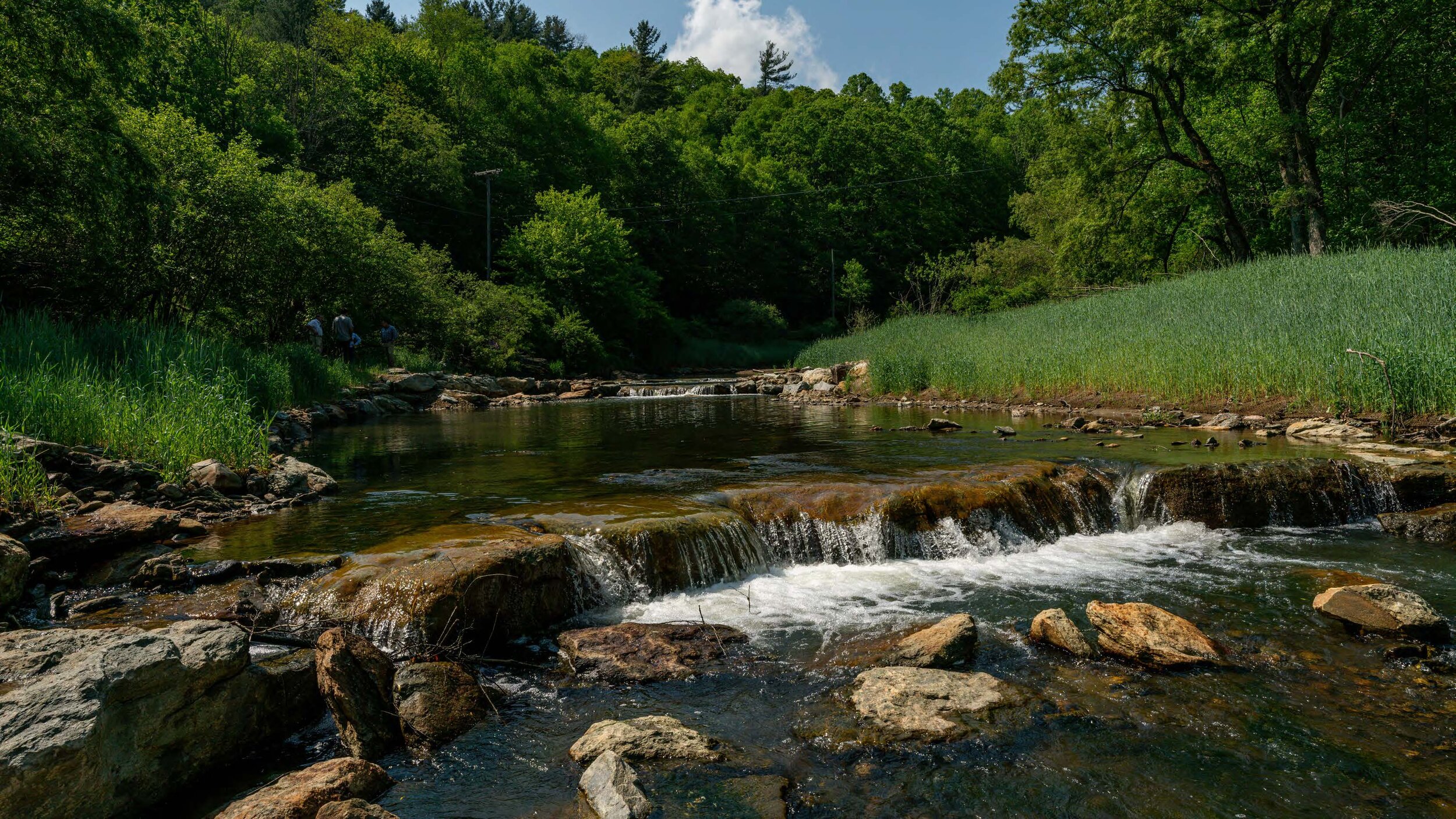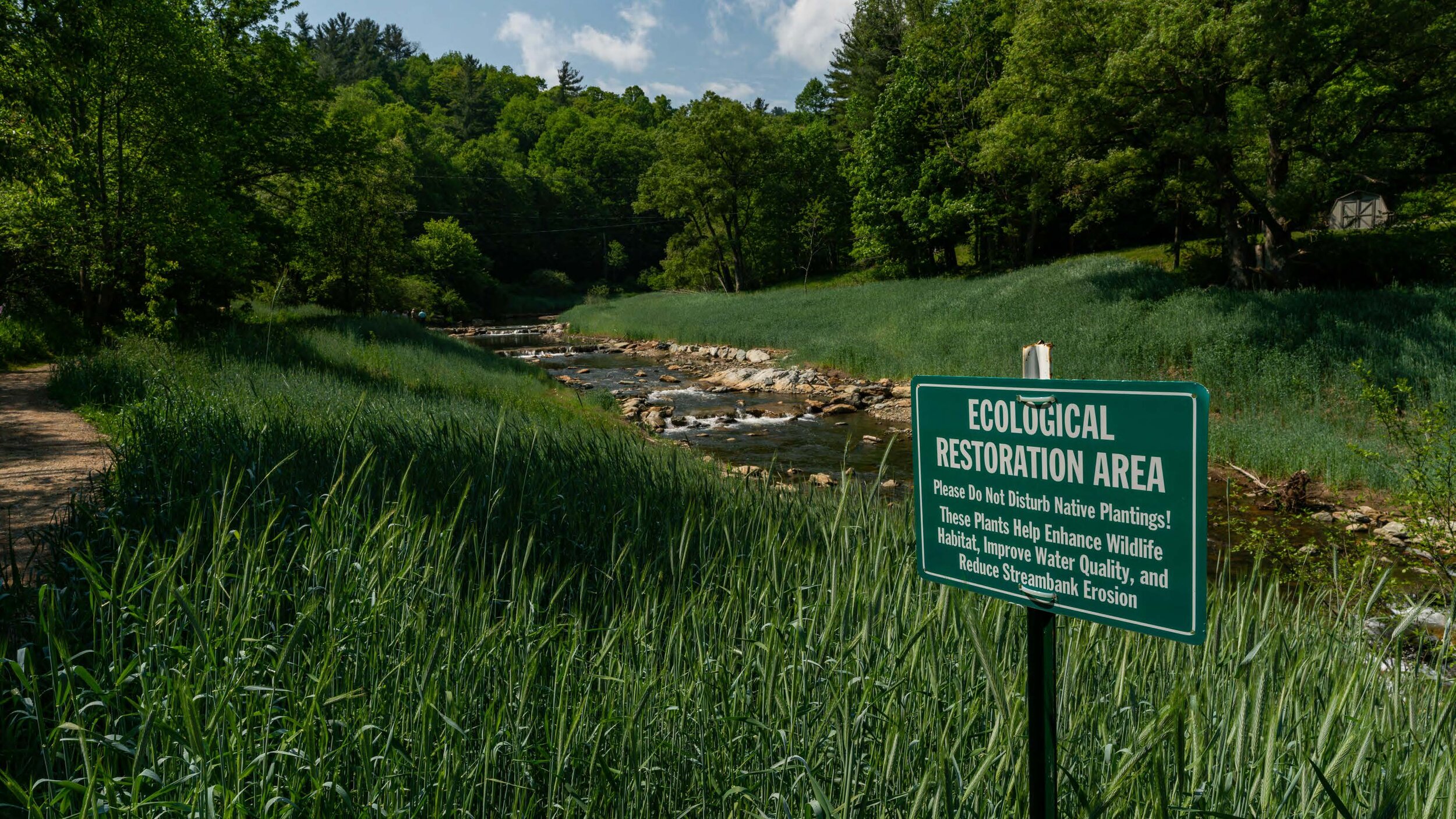After the dam was removed, instream structures were installed in the new channel. The structures will create and enhance aquatic habitat and restore the natural water flow of Payne Branch.
Boone, NC
An unprecedented partnership between Resource Institute, a Winston-Salem, NC, based nonprofit, and Appalachian State University, New River Light & Power (NRLP) restored a section of Payne Branch, along the Middle Fork of the New River. As part of the restoration project, the partners removed a decommissioned hydroelectric dam. The project is located just east of Boone at Payne Branch Park.
NRLP supplies electrical service to Appalachian State University, the Town of Boone, and the surrounding community. NRLP once used the Payne Branch dam as a power source (1924–72). According to Matthew Makdad, PE, Engineering Supervisor at NRLP. "The watershed upstream of the site was impacted by development and highway expansion," he explained. "This, plus the remaining dam structure, subsequently restricted the Middle Fork, causing increased stormwater flow and sediment levels that impacted the water quality in this habitat."
The restoration project reconnected Payne Branch to its floodplain and created a riparian buffer. The project partners planted 800 trees and 2,000 shrubs and plants. Over ten years, the trees will sequester 40,872 pounds of carbon dioxide, and the shrubs will sequester 19,160 pounds of carbon dioxide.
Payne Branch experienced multiple physical, ecological, and biological impacts. The old dam structure restricted streamflow, causing increased stormwater flow and sediment levels, poor water quality, and reduced habitat. The Payne Branch Project partners removed the existing dam, removed excess sediment, restored and stabilized stream banks, reconnected and enhanced the floodplain and ponds. Dam Removal and restoration also allow upstream fish passage for spawning. This epic project relocated 18,000 cubic yards of sediment.
The Payne Branch Project Team Leaders at Payne Branch Park - (left to right) Charles Anderson, Resource Institute, Ken White, Resource Institute & Applachian State, Ed Miller & Matt Makdad, Appalachian Light & Power, Debbie Dodson, Resource Institute, Adam Williams, Brush Fork Environmental, Chana Howson, Appalachian State, and Darrell & Stephanie Westmoreland, North State Environmental.
The project also created an enhanced riparian buffer, removed invasive plant species, and reestablished native plants, trees, and shrubs. The project partners planted 800 trees and 2,000 shrubs and plants. Over ten years, the trees will sequester 40,872 pounds of carbon dioxide, and the shrubs will sequester 19,160 pounds of carbon dioxide. In addition to cleaner water, the residents will breathe fresher air.
Appalachian State University, NRLP, with assistance from Resource Institute, received a $1.177 million grant from the NC Land & Water Fund to implement the project. NRLP contributed an additional $200,000 to the effort. Brushy Fork Environmental Consulting, Inc. completed the assessment, engineering, and design. North State Environmental constructed the project last summer and early fall.
The decommissioned hydroelectric dam on Payne Branch prior to removal. The dam posed a significant safety risk.
Resource Institute, the project manager, has a 20-year history of managing stream restoration projects. Ken White, Chair of Resource Institute, says, "It seems paradoxical to refer to one of the oldest rivers in the world as the New River. The work Resource Institute and our conservation partners performed removing the dam on the New River will pay dividends we cannot begin to calculate. Healthy rivers make our communities resilient and vibrant. Restoration of the river's flow, fish habitat, wildlife sanctuary, increased recreational opportunities, and release of trapped sediment will benefit our region immeasurably."
In total, the project restored 1,200 linear stream feet. The Payne Branch Project is part of the future extension of the Greenway Trail between Boone and Blowing Rock. The project will expand community and tourist recreation opportunities. Payne Branch will also see a decrease in stormwater flows and sediment deposits. Stabilized streambanks and the new riparian buffer will reduce erosion, improve water quality, enhance habitat, and positively impact the trout fishery.
By Resource Institute’s Technical Writing Team - Paula Worden, Alan Walker & Squeak Smith.




